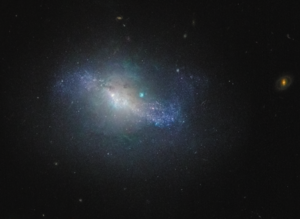NGC 4670
| Galaxie NGC 4670 | |
|---|---|
 | |
| Abbildung von NGC 4670 unter Verwendung von Daten des Hubble-Weltraumteleskops | |
| AladinLite | |
| Sternbild | Haar der Berenike |
| Position Äquinoktium: J2000.0, Epoche: J2000.0 | |
| Rektaszension | 12h 45m 17,1s[1] |
| Deklination | +27° 07′ 31″ [1] |
| Erscheinungsbild | |
| Morphologischer Typ | SB(s)0/a / pec: / BCDG [1][2] |
| Helligkeit (visuell) | 12,2 mag [2] |
| Helligkeit (B-Band) | 13,1 mag [2] |
| Winkelausdehnung | 1,4 × 1,2 [2] |
| Positionswinkel | 90° [2] |
| Flächenhelligkeit | 12,6 mag/arcmin² [2] |
| Physikalische Daten | |
| Rotverschiebung | 0,003566 ± 0,000013 [1] |
| Radialgeschwindigkeit | (1069 ± 4) km/s [1] |
| Hubbledistanz vrad / H0 | (48 ± 3) · 106 Lj (14,7 ± 1,0) Mpc [1] |
| Geschichte | |
| Entdeckung | Wilhelm Herschel |
| Entdeckungsdatum | 6. April 1785 |
| Katalogbezeichnungen | |
| NGC 4670 • UGC 7930 • PGC 42987 • CGCG 159-069 • MCG +05-30-072 • IRAS 12428+2724 • 2MASX J12451714+2707317 • Arp 163 • GC 3201 • H III 328 • h 1422 • LDCE 867 NED126 | |
NGC 4670 = Arp 163 ist eine 12,2 mag helle linsenförmige Zwerggalaxie vom Hubble-Typ SB0/a im Sternbild Haar der Berenike am Nordsternhimmel. Sie ist schätzungsweise 48 Millionen Lichtjahre von der Milchstraße entfernt und hat einen Durchmesser von etwa 20.000 Lichtjahren.
Halton Arp gliederte seinen Katalog ungewöhnlicher Galaxien nach rein morphologischen Kriterien in Gruppen. Diese Galaxie gehört zu der Klasse Galaxien mit diffusen Filamenten.
Im selben Himmelsareal befinden sich u. a. die Galaxien NGC 4673 und NGC 4692.
Das Objekt wurde am 6. April 1785 von Wilhelm Herschel mit einem 18,7-Zoll-Spiegelteleskop entdeckt, der sie mit „F, S“[3] beschrieb.[4]
Literatur
- Jeff Kanipe und Dennis Webb: The Arp Atlas of Peculiar Galaxies – A Chronicle and Observer´s Guide, Richmond 2006, ISBN 978-0-943396-76-7
Weblinks
- Seligman Arp
- NGC 4670. DSO Browser, abgerufen am 1. Februar 2015 (englisch).
- ARP ATLAS OF PECULIAR GALAXIES
- NGC 4670. SIMBAD, abgerufen am 1. Februar 2015 (englisch).
Einzelnachweise
Auf dieser Seite verwendete Medien
Autor/Urheber: Judy Schmidt from USA, Lizenz: CC BY 2.0
A dwarf galaxy bustling with star formation, as evidenced by the tendrils of emission nebula appearing green here due to the choice of filters. The emission must be very strong indeed, for it is visible even in wideband color. A narrowband filter would bring out a lot of details in the nebula.
In my own mind I call these star seams due to their linear appearance and the way the nebula tends to look like it is flowing out from the vein of star formation. You can see a spectacular example of one of these with appropriate narrowband filters included here: flickr.com/p/pTDvDs
Color comes from this SDSS field: dr12.sdss.org/fields/name?name=arp+163
HST Proposal: Establishing HST's Low Redshift Archive of Interacting Systems
Luminosity: ACS/WFC F606W Red: SDSS i Green: SDSS r Blue: SDSS g
North is 20.91° clockwise from up.


